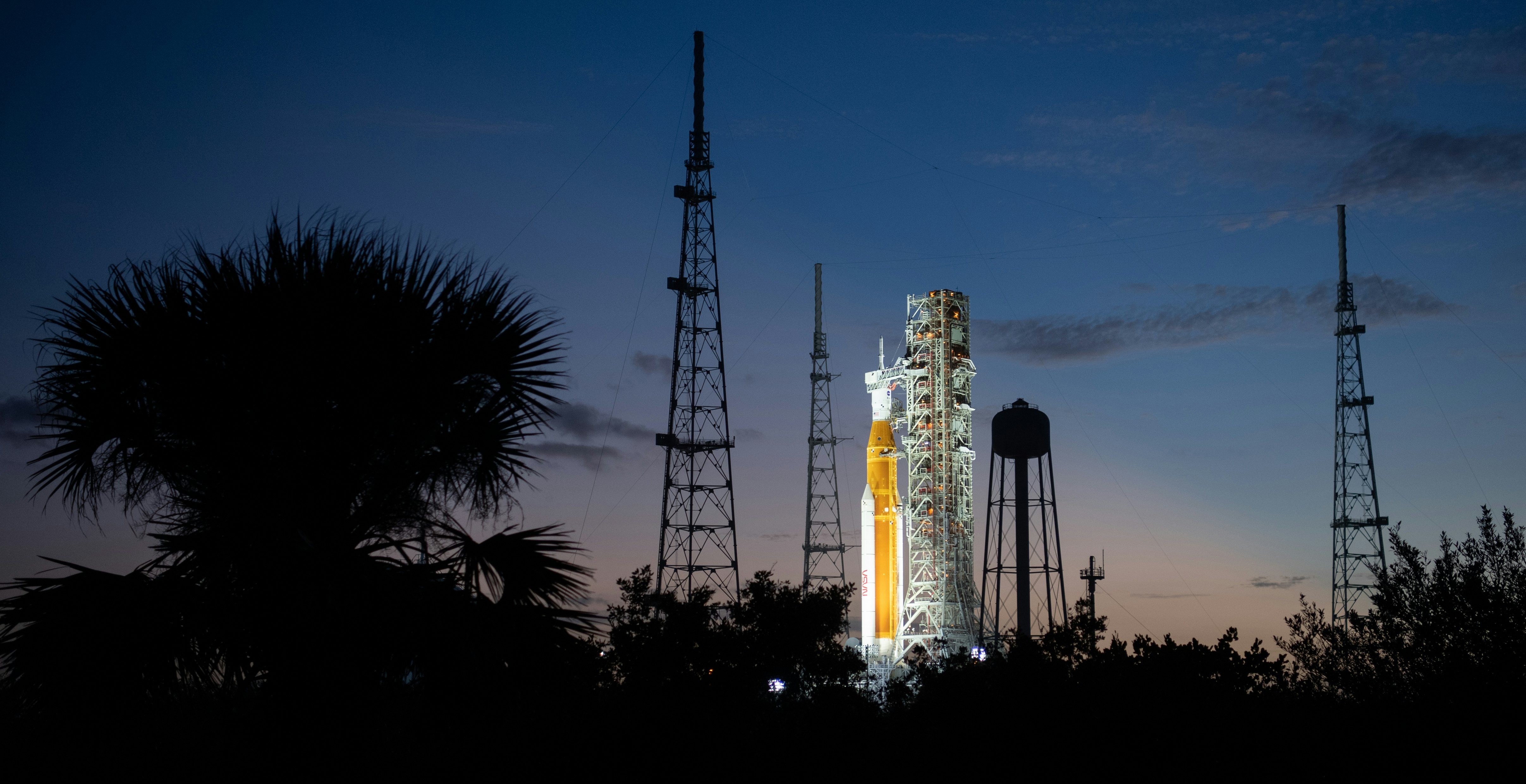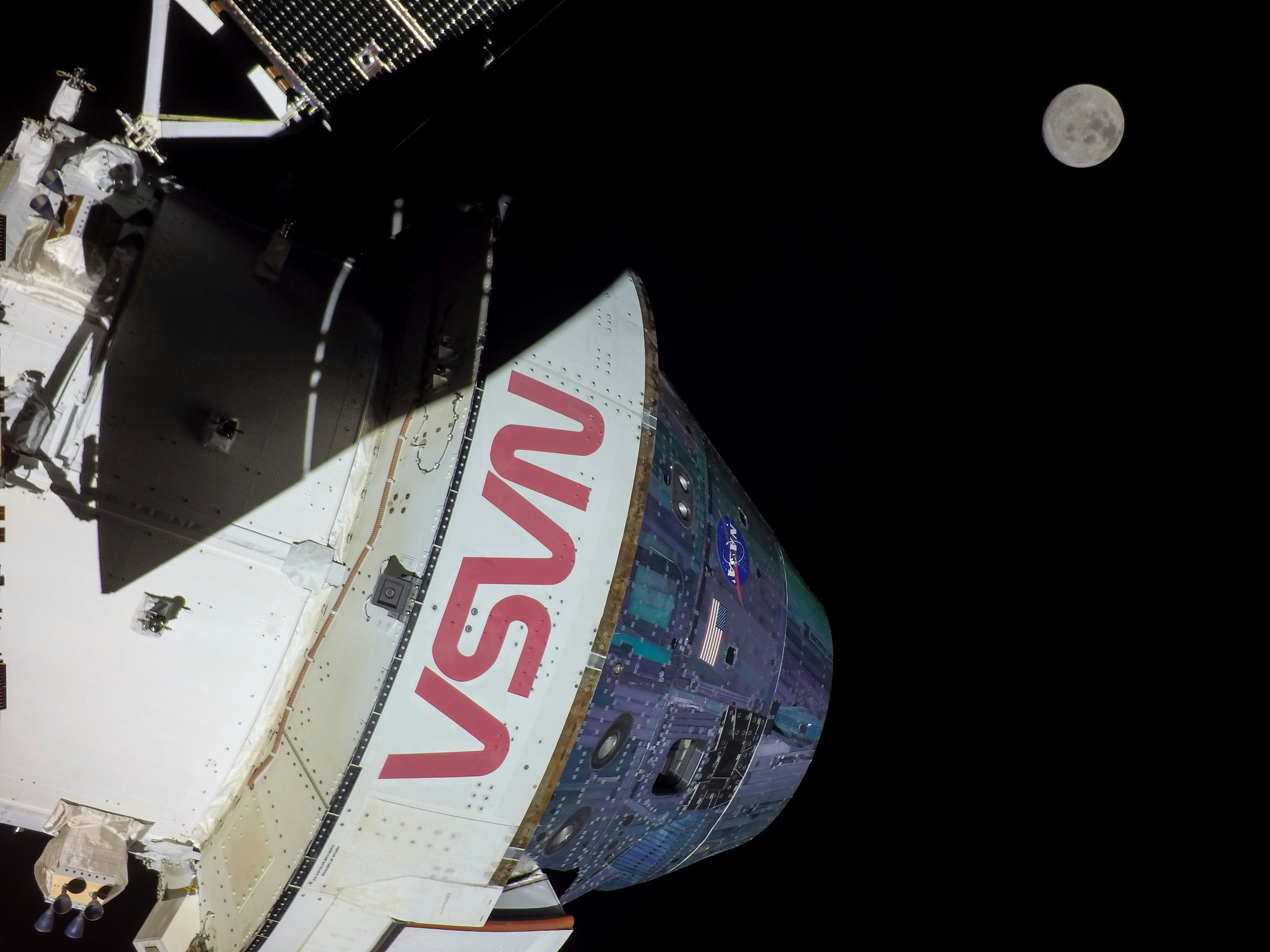
Exploring space feels like it’s encoded in my DNA.
I’ve been a sci-fi dork for decades, since I was a wee lad. I was practically raised on movies and TV shows depicting humanity’s noble ventures into the galaxy and loved the very notion of it. I can’t tell you how many times I watched movies like Destination Moon, which, while a bit cheesy, still used pretty solid engineering and science principles to depict a rocket flight to the Moon and back. As an astronomer, I find it impossible to look at the Moon or Mars through a telescope and not feel a profoundly compelling desire to know them better.
But it’s a fundamental aspect of science to question assumptions and see what gives. That is, after all, how we get closer to the truth.
I’ve been doing a lot of that lately, thinking through my own unwavering devotion to putting humans on another world. While I still think it should be done, I have to admit, I’m conflicted about NASA’s big push to return to the Moon.
A New Space Race

We haven’t been back to the Moon in over 50 years, and thanks to 20-20 hindsight, the reason is obvious: The Apollo program was designed so the U.S. could win the Space Race and beat the Soviets to the Moon. And it worked! But what happens when a race is over? Everyone packs up and goes home.
In a sense, the future of Apollo was doomed the moment Neil Armstrong planted his foot on the lunar surface. But the total time humans had boots on the Moon was a mere 80 hours; just over three days. And those astronauts explored a very small area of the Moon around their landing sites. Add to these constraints the fact that only one classically trained scientist was ever part of those missions, on Apollo 17 — the last flight. All that effort to spend a long weekend on the only other world we’ve ever visited. It’d be like going all the way to Antarctica by sail boat, touching your toe on the ice, declaring the continent explored, and then going home never to return.
It’s actually a decent analogy. The first explorers to go to Antarctica barely got past the coastline. It was decades before a more permanent base was set up by an international coalition. And now, with global cooperation, the austral continent is used purely for scientific research for the benefit of all humanity. We’ve learned a huge amount across a spectrum of subjects — from geology to meteorology to climate to physics — just by being there.
Obviously, the Moon is not Earth — to live there is to contend with a very different (and hostile) environment. The Moon will kill you without a second thought; there’s no air, with huge swings in temperature, lethal solar radiation, and more.
The sheer complexity of the science and engineering we have yet to achieve in order to live for any meaningful period of time in space, on the Moon, or in a spaceship for the months-long voyage to Mars is daunting. It would be glib to say they’ll be solved soon, but enough progress is being made that I can hold on to hope.
No. The far spikier thorn, in my opinion, isn’t typically featured in the sci-fi stories I love, perhaps because it is too complex.
It’s politics.
As the main bankrollers for space agencies, the world’s governments play an outsized role in space science and exploration, and these political winds turn on what can seem like a whim.
NASA is betting billions of dollars to send humans back to the Moon and even Mars — supposedly to stay. To be clear: I absolutely, 100 percent, want humans to explore space. But… are we doing it the right way?
Presidential Ping Pong

To try and answer my question, let’s rewind the clock to 1989.
On the 20th anniversary of Armstrong and Aldrin’s Apollo 11 flight, President George H. W. Bush announced an initiative to return to the Moon. Then, Bill Clinton was elected in 1992, and the focus pivoted to the International Space Station.
President George W. Bush made the Moon an ever more distant target. In 2004, he announced NASA’s flagship Space Shuttle program would be replaced by newer, more powerful rockets designed to fly humans into deeper space. That effort, called Constellation, ran over budget and behind schedule. Bush’s successor Barack Obama replaced Constellation with an enormous heavy-lift rocket called the Space Launch System also capable of sending large payloads, including humans, into deep space.
Ironically, NASA found renewed enthusiasm for the Moon during Trump’s administration. The most anti-science administration in decades, Trump’s involvement with NASA began on a different footing to his predecessors thanks to some critical scientific discoveries and the nascent space exploration industry.
Some years earlier, water had been found in the form of ice buried in deep craters at the Moon’s south pole, and further research showed there could be billions of tons of it. Humans have this inconvenient need to drink and breathe. Water can satiate the former, and breaking water into its atomic components can provide oxygen for the latter. As a bonus, the hydrogen in water molecules can fuel rockets. It is not hyperbole to say this discovery is one of the most important findings of our age.

So in 2017, when NASA announced Project Artemis, the nation’s effort to return to the Moon, it was perhaps no surprise. Artemis would rely on the Obama-era Space Launch System rocket and its companion Orion space capsule, which can support a crew of six people.
At the time, I was skeptical to the point of laughter. The SLS was running late and over budget. Congress had put its thumb on the scale; a program this large can benefit every state and district in the country, so politicians can’t resist pork barreling it — even to the point of failure. The back and forth on a governmental whim makes it nearly impossible for NASA to define goals and attain them — the rug is yanked out from under the agency’s feet every four to eight years.
In 2019, Trump’s White House added fuel to the (potential dumpster) fire. The administration announced it wanted to see humans back on the Moon by 2024. I may have groaned out loud when I heard that. An accelerated schedule would all but guarantee failure. Too much too soon, especially when dealing with vastly complex engineering, is not just a bad idea, it’s dangerous. A similar attitude is what led to the first Space Shuttle disaster.
Lest we forget, the Space Shuttle was billed as inexpensive, safe, and reliable. It was many things, but it was none of those things. SLS seems to be making those same mistakes.
So, as I said, I’m conflicted about the return to the Moon. I want NASA to do it, but the SLS feels like a huge boondoggle. Yet it is also true that the SLS’s complexity and the delays in building it may also have been Artemis’ saving grace.
Artemis Rising

In the several years worth of delays as a result of the SLS’s difficult construction, Artemis survived the Trump administration to finally pull off its first launch in November 2022. It appeared to go well, flinging an uncrewed Orion capsule into a loose orbit around the Moon and back to Earth. The second mission — Artemis 2 — is scheduled for no earlier than May 2024 (although history should tell you not to hold your breath). Carrying a crew of four, it will go on a similar trajectory as the first flight, making a lunar flyby during the 25-day mission.
Artemis 3, planned for 2025, will send four astronauts into lunar orbit, with two of them descending to the surface. I still think this date is aspirational given the SLS history, but even if delayed it will mark our return to the Moon.
But there’s more hopeful news, too.
During all this time, SpaceX has not-so-quietly been developing Starship, its next generation rocket. It’s a two-stage vehicle that has more thrust than SLS and will be fully reusable with both the booster and the upper stage capable of landing again after launch (the footage of upper stage test flights is extremely dramatic). Even better, the cost is estimated to be $150 to $250 million per launch, while the SLS costs an estimated $4 billion per launch.
Starship has yet to fly — its first test flight is planned for literally any day now — but I wouldn’t bet against this vehicle. In February 2023, SpaceX successfully landed its 100th consecutive Falcon 9 booster. As space journalist Eric Berger points out, no other rocket in history has had 100 successful flights ever. It’s an astonishing achievement.
NASA has enough trust in SpaceX that it’s relying on the company for the Artemis 3 lunar landing. The crew will launch onboard an SLS that will send them into lunar orbit. From there, the SpaceX Starship Human Landing System, a variant of the Starship rocket, will be used to land two of them on the lunar surface.

SpaceX also wants Starship to take humans to the Moon on its own. If that’s successful, then it’s possible NASA might consider replacing SLS with Starship.
But more than anything else, what makes me hopeful is that I’m seeing a serious push toward sustainability and international cooperation that eluded earlier exploratory efforts.
Artemis has international partners (the EU, Japan, and Canada) built in from the start. There’s a big push for science and engineering as part of the mission goals as well, mostly to help support the people who go but also for more far-thinking research as well.
Artemis is designed to go back to stay, and even venture farther. Funding is going to science and engineering efforts to investigate growing plants on the Moon, piping oxygen from the south polar mines to bases where humans will live, using the regolith — the pulverized lunar rock covering the Moon’s surface — as a building material for habitats, and more. A lot of the details are being worked out on how to actually live on the Moon, as opposed to just visiting it. Indeed, NASA and SpaceX are already looking beyond the Moon, to Mars.
Mars is a much more difficult destination than the Moon. It takes months just to get there. There are even more significant radiation hazards, long delays in communications, a lack of supply lines to Earth, and many more obstacles— not to mention the social implications of such an undertaking need to be examined very, very carefully as well. But engineering and scientific problems are perhaps not nearly as abstruse as political ones.
NASA hopes to send humans to Mars sometime in the 2030s — likely three or more Presidential elections from now. The course NASA is on right now looks like a good one. Let’s hope the political trajectory is also true.
!["[T]he First and Fifth Amendments Require ICE to Provide Information About the Whereabouts of a Detained Person"](https://images.inkl.com/s3/publisher/cover/212/reason-cover.png?w=600)






